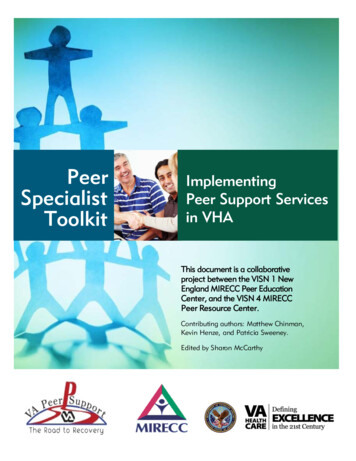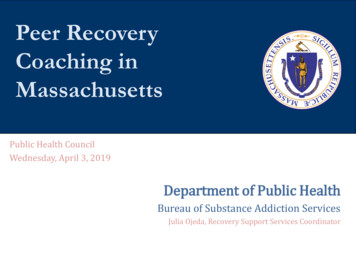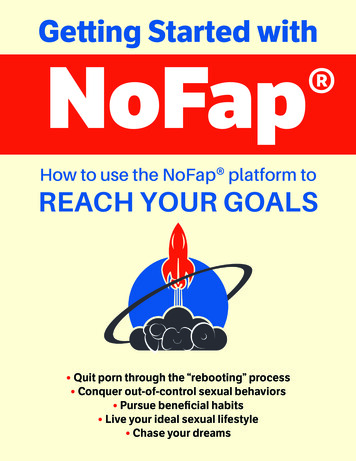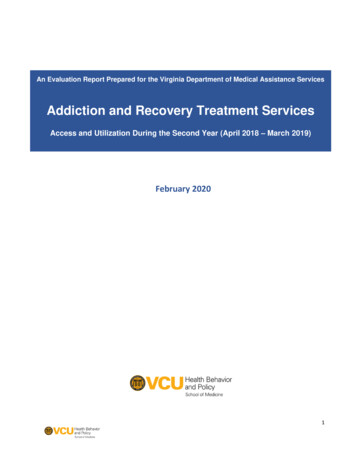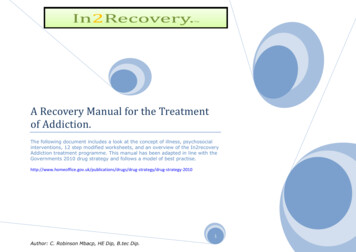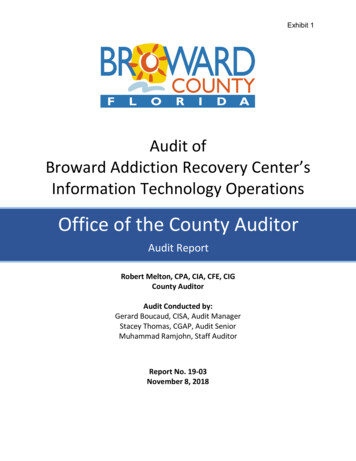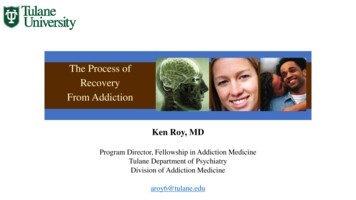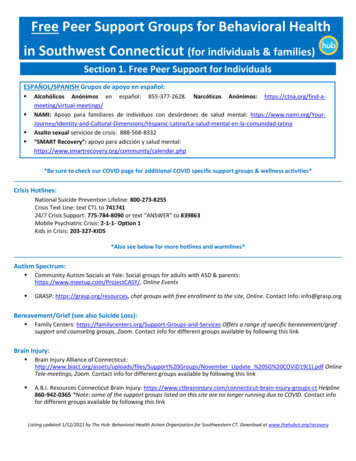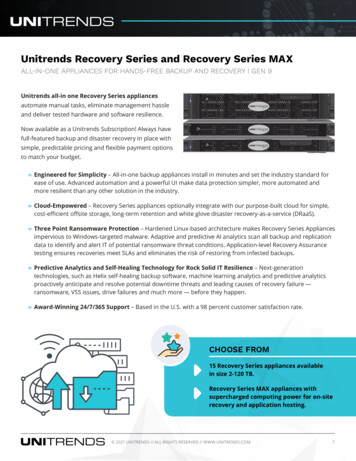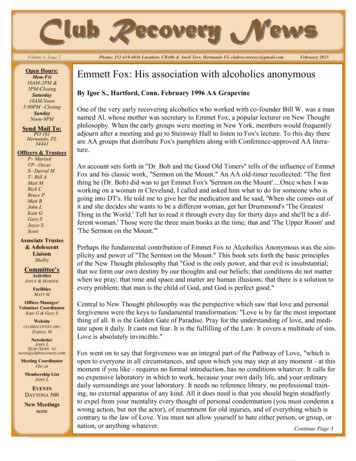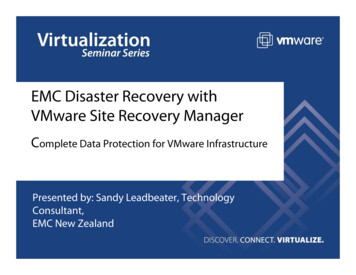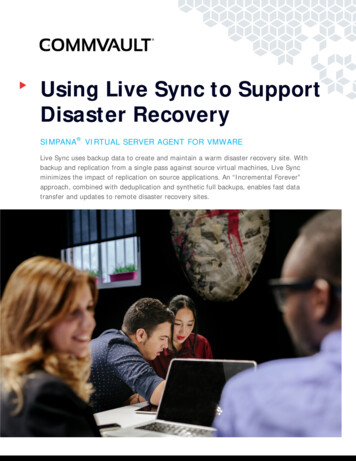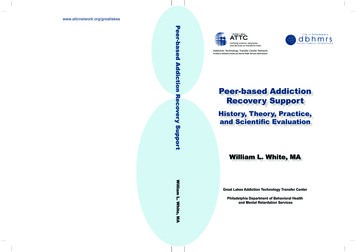
Transcription
Peer-based Addiction Recovery SupportHistory, Theory, Practice, and ScientificEvaluationWilliam L. White, MAGreat Lakes Addiction Technology Transfer CenterPhiladelphia Department of Behavioral Health and MentalRetardation Services
DedicationThis monograph is dedicated to:Barbara Weiner and Rebecca Rowe of Hazelden Library,and to Stephanie Merkle and Christopher Roberts, researchassistants at Chestnut Health Systems. This monographwas possible only through their tenacious efforts to procurehundreds of historical documents, scientific studies, tradejournal articles, posted papers, conference presentations,and other unpublished manuscripts. Barbara, Rebecca,Stephanie and Christopher, and their counterparts aroundthe country receive far less acknowledgment for theircontributions to the field than they deserve.Thomasina Borkman, for her pioneering work on experientiallearning and peer-based recovery support organizations.Those working on the front lines of peer-based addictionrecovery support services. Thank you for opening your livesand your organizations to me.i
ii
Table of ContentsWelcome from Lonnetta Albright and Michael Flaherty, PhD . 1Foreword by Arthur C. Evans, PhD and Beverly J. Haberle, MHS. 3Abstract . 7IntroductionSummary of Key Points. 9The Recovery Management Monograph Series . 9Purpose of the Current Monograph . 11A Note on Language . 12A Caution to the Reader. 12Acknowledgments . 13Chapter One: Defining Peer-based Recovery Support ServicesSummary of Key Points. 15Defining Peer Recovery Support . 16Distinguishing Professional and Peer Support . 19Core Characteristics of P-BRSS Specialists. 22Varieties of Peer Recovery Support Services. 25Core Functions. 27Treatment Adjunct or Alternative . 29Chapter Two: The History of Peer-Based Recovery Support ServicesSummary of Key Points. 31Solo Practitioners . 34Peer Recovery Support and Religious/Cultural Revitalization Movements . 35Secular Recovery Mutual-aid Societies . 36Spiritual Recovery Mutual-aid societies . 37Religious Recovery Mutual-aid societies . 37Family-Focused Recovery Support Societies . 38Occupation-based Recovery Support Groups . 38Shared Characteristics of Recovery Support Groups. 38Recovery Support for Special Populations . 39Gender-specific mutual-aid groups. 39Age-specific recovery support . 40Recovery mutual aid and advocacy in communities of color . 40Recovery support for and within the LGBT community . 41Recovery support for people with co-occurring disorders. 41Recovery support for people embedded within the criminal justice system. 41Recovery mutual aid in rural communities. 42Geographical Accessibility of Recovery Mutual-aid Groups . 42Internet-based Recovery Support . 47Recovery Community Service Institutions and Organizations . 47Recovery Social Clubs . 48Recovery Advocacy Organizations . 49Recovering People Working in Non-professional Support Roles in . 50Addiction TreatmentRecovering People Working in Professional Roles in Addiction Treatment . 53Current Recovery Coaching Practices in the Public and Private Sectors . 62iii
Chapter Three: The Theoretical Foundations of Peer-Based RecoverySupportSummary of Key Points. 67“Nothing about us without us” . 69The Wounded Healer Tradition. 71The Power of Calling (Amends in Action) . 73Experiential Knowledge. 74Chronic Illness and Peer Support . 78Charisma and Recovery. 80Spirituality and Recovery . 84Storytelling and the Power of Mutual Identification. 85Stigma and The Dynamics of Help-seeking. 88Sharing Recovery Capital . 92The Helper Therapy Principle . 93Individual, Community, Culture . 94Cultures of Addiction and Recovery. 96Preventing Harm in the Name of Help . 97Stewardship of Community Resources. 99The Threats of Anti-professionalism and Professionalism . 100Primacy of Personal Recovery and Importance of Self-Care . 103Role of Risk in Recovery. 105The Value of P-BRSS . 105Criticism of P-BRSS . 107Testing the Theoretical Foundations of P-BRSS . 109Chapter Four: Scientific Evaluation of Peer-based Support:Studies of the Effects of Participation in Recovery Mutual-aidSocietiesSummary of Key Findings . 113Limited Scope of Research on Recovery Mutual-aid Societies . 115Role of Mutual Aid in Recovery Outcomes . 117Variability of Response . 119Effectiveness across Diverse Populations . 120Cost-effectiveness. 125The Question of Harm (Iatrogenesis). 126Potent Ingredients of Recovery Mutual Aid . 128Additive Effects of Professional Treatment and Mutual Aid. 130Timing of Participation. 131Linkage Procedures and Participation Rates. 132Linking Adolescents to Recovery Support Groups . 133Early Drop-out Rates. 134Dose and Intensity of Participation Effects . 136Frequency of Participation . 136Duration of Participation. 137Role of Internet-based Recovery Support. 138Relationship between Helping and Helper Recovery Outcomes . 139Studies of Family Support Groups . 140iv
Chapter Five: Scientific Evaluation of Peer-based Services:Studies of the Effects of Participation in other RecoveryCommunity InstitutionsSummary of Key Findings . 145Recovery Social Clubs . 146Recovery Community Centers . 147Recovery Homes. 149Recovery Colonies . 154Recovery Schools . 155Peer-based Occupational Recovery Support . 158Recovery Ministries/Recovery Churches . 160Other Recovery Support Structures. 162Chapter Six: Scientific Evaluation of Peer-based Services:Studies of Recovering People Working in Addiction TreatmentSummary of Key Findings . 165Science versus Stereotypes . 166Recovery Representation in Addiction Treatment . 167The Role Transformation of Addiction Counselors in Recovery. 171Demographic Profile of Counselors in Recovery . 174Prior Treatment/Recovery Experience of Counselors in Recovery . 174Pre-service Educational Functioning of Counselors in Recovery. 175Educational Levels of Recovering People Working as Addiction Counselors . 175Certification, Licensure, and Clinical Effectiveness . 176Compensation of Recovering Counselors versus Counselors Without a . 178History of AddictionPersonality Characteristics of Recovering Addiction Counselors. 178Beliefs and Attitudes of Recovering Addiction Counselors. 179Attitudes and Behaviors of Recovering Counselors Related to Evidence-. 184based PracticesRole Perceptions of Recovering Addiction Counselors . 186Recovery Status and Client Perceptions of Credibility and Effectiveness. 186Counselor Recovery Status and Therapeutic Alliance . 188Counselor Recovery Status and Ethical Decision-making. 189Counselor Recovery Status and Client Recovery Outcomes . 191Recovery Status and General Job Performance Factors . 196Vulnerability to Relapse among Counselors in Recovery . 196Influence of Recovery Status on Supervisory Relationships . 197Evaluation of Treatment Models Staffed by Recovering People . 198Evaluation of Recovery Volunteer Programs Linked to Addiction . 202Treatment or Medical TreatmentRelevant Studies on Peer-based Services from Allied Fields. 204Commentary on Lack of Distinctive Findings. 207v
Chapter Seven: Recent Studies of Recovery Coachingand P-BRSSSummary of Key Findings . 209The Recovery Community Services Program (RCSP) . 209The Access to Recovery (ATR) Program. 211Studies of Service Elements related to P-BRSS . 213Chapter Eight: A P-BRSS Research AgendaSummary of Key Findings . 217Toward a Recovery Research Agenda . 217Communities of Recovery as Ethno-cultural Communities. 218Research on Recovery Mutual-aid Groups. 220Participation in Other Recovery Community Institutions. 221Recovery Representation in Professional Treatment . 221Person-specific Factors Affecting Recovery Outcomes. 222P-BRSS and Stages of Recovery . 223P-BRSS Service Roles. 223Service Ingredients and Recovery Outcomes . 224Interaction Between P-BRSS and Professional Treatment . 225P-BRSS and Family/Community Recovery Outcomes . 226Organizational Contexts and P-BRSS Outcomes. 227Concerns About P-BRSS . 228Chapter Nine: Summary and Conclusions . 231A Preview . 235AppendixTable 12: Changing Recovery Representation in the Addiction . 237Treatment WorkforceList of TablesTable 1: Professional and Peer Models of Helping. 20Table 2: Defining Characteristics of P-BRSS . 22Table 3: Defining Characteristics of Organizations Delivering P-BRSS . 26Table 4: Geographical Dispersion of Addiction Recovery Mutual-aid . 43Groups in the United StatesTable 5: Paradigms of “Paraprofessional” and Professional Addiction . 59CounselingTable 6: Academic Theories on Mutual Peer Assistance . 68Table 7: Performance Measures and P-BRSS Core Ideas . 109Table 8: Demographic Characteristics of Recovery Mutual-aid societies . 123Table 9: Al-Anon Membership Characteristics in the United States,. 1411984 and 2006.Table 10: Recovery Representation Among Counselors Working in . 168Addiction Treatment: 1960-2007Table 11: Concerns about P-BRSS Raised by Addiction Professionals, . 228Treatment Administrators, and Members of the Recovery CommunityTable 12: Changing Recovery Representation in the Addiction . 237Treatment Workforcevi
Program ProfilesProgram Profile 1: Peer Group Facilitation Training . 47(previously called “How to Start Your Own Self-help Group”)Program Profile 2: PRO-ACT Philadelphia . 48Program Profile 3: Recovery Walk 2008 . 50Program Profile 4 : Telephone Recovery Support . 63Program Profile 5: New Pathways Project . 64(Assertive Street and Community Outreach)Program Profile 6: Recovery Advisory Committee . 69Program Profile 7: Recovery Foundations Training. 70Program Profile 8: Peer Leadership Academy . 70Program Profile 9: A New Day: A Celebration of Recovery. 71Program Profile 10: Amends in Action . 74Program Profile 11: Storytelling Training . 88Program Profile 12: Taking Recovery to the Streets . 92Program Profile 13: Vermont Recovery Center Network . 148Program Profile 14: Philadelphia Recovery Community Center . 149Program Profile 15: Recovery Home Survey . 153Program Profile 16: Connecticut Community of Addiction Recovery’s. 153Recovery Housing ProjectProgram Profile 17 : Recovery Oriented Employment Services . 159Program Profile 18: NET Consumer Council . 163Program Profile 19: Peer Specialist Initiative. 170vii
viii
WelcomeLonnetta Albright, Executive DirectorGreat Lakes Addiction Technology Transfer CenterMichael T. Flaherty, PhD, Principal InvestigatorNortheast Addiction Technology Transfer CenterWe welcome you to this, the sixth effort in our monograph seriesdesigned to explore in depth the theoretical and practical aspects of peer-basedaddiction recovery support services and recovery-oriented systems of care.Once again, we have had the benefit of William L. White’s expertise and passionin the conception and execution of this document.After all the dedication, skill, and care that addiction professionals devoteto our clients’ well being, we all too often see our best work erode as fragilepeople return to the same circumstances and environments that fostered theirillness. The peer-based recovery support model has arisen to nourish andprotect the recovery that in many cases starts in professional treatment, and fromthe beginning William L. White has been one of its strongest champions.As someone who has spent most of his career working toward
Aug 18, 2008 · Relevant Studies on Peer-based Services from Allied Fields.204 Commentary on Lack of Distinctive Findings.207 . vi Chapter Seven: Recent Studies of Recovery Coaching and P-BRSS . addiction recovery support services and recovery-oriented systems of care. Once again, we have had the benefit of William L. White’s expertise and passion .
